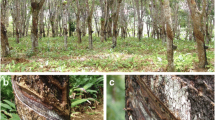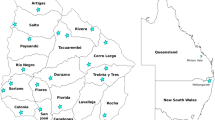Abstract
Ceratocystis fimbriata is a native, soilborne pathogen in South America that causes a lethal wilt disease on a broad range of economically important plants. Ceratocystis wilt on kiwifruit (Actinidia spp.) was first recognized in 2010 in the state of Rio Grande do Sul, Brazil. The genetic variation among kiwifruit isolates was analized to determine if a single introduced strain of the pathogen was responsible for the epidemic or if there was substantial genetic variation in the population, suggesting that the fungus was soilborne and indigenous to the region. We used 14 microsatellite (simple sequence repeat, SSR) markers to identify 18 genotypes of C. fimbriata among 76 isolates from eight kiwifruit farms. The 18 genotypes clustered into three groups based on UPGMA analysis of the microsatellite alleles. The largest group comprised 60 isolates of 11 closely-related microsatellite genotypes obtained from seven of the eight farms. These genotypes appeared to have originated from a single farm that had supplied cuttings for grafting to the other farms. The population of the pathogen from the farm that supplied the cuttings had the highest level of genotypic diversity and relatively high gene diversity, suggesting that this source population represented an indigenous, soilborne population. Phylogenetic analyses of the DNA sequences of the mating type locus (including portions of MAT1-1-2 and MAT1-2-1) placed the isolates into three groups, corresponding to the three microsatellite groups. Most of the isolates, including all the tested isolates from the farm that supplied the cuttings, had mating type gene sequences that were distinct from other Brazilian populations of C. fimbriata. A second group comprised isolates from one farm that had mating type gene sequences typical of Mata Atlântica (Rio de Janeiro and São Paulo) populations of C. fimbriata on Colocasia esculenta and Mangifera indica. Three farms purchased kiwifruit plants or rootstocks from commercial nurseries in Brazil as well as scions from the source farm, and some of the isolates from these farms were genetically similar to Eucalyptus isolates of C. fimbriata from Bahia and Minas Gerais, Brazil. The kiwifruit epidemic in Rio Grande do Sul is the southern-most report of C. fimbriata in Brazil, and the primary pathogen population on kiwifruit appears to be indigenous and originated from a single farm that distributed the pathogen in grafting material. In addition, commercial nursery stock was also implicated as sources of C. fimbriata genotypes. The disease is a major limiting factor for kiwifruit production in southern Brazil, and the results suggest that clean planting stock will be important to successful production.



Similar content being viewed by others
References
Baker CJ, Harrington TC, Krauss U, Alfenas AC (2003) Genetic variability and host specialization in the Latin American clade of Ceratocystis fimbriata. Phytopathology 93:1274–1284
CAB International (2001) Ceratocystis fimbriata (original text prepared by T.C. Harrington and C. Baker). In: Crop Protection Compendium. CAB International, Wallingford
Castellani A (1939) Viability of some pathogenic fungi in distilled water. Am J Trop Med Hyg 24:270–276
Engelbrecht CJB, Harrington TC (2005) Intersterility, morphology and taxonomy of Ceratocystis fimbriata on sweet potato, cacao and sycamore. Mycologia 97:57–69
Engelbrecht CJB, Harrington TC, Steimel J, Capretti P (2004) Genetic variation in eastern North American and putatively introduced populations of Ceratocystis fimbriata f. platani. Mol Ecol 13:2995–3005
Engelbrecht CJ, Harrington TC, Alfenas AC, Suarez C (2007) Genetic variation of populations of the cacao wilt pathogen, Ceratocystis cacaofunesta. Plant Pathol 56:923–933
Ferreira EM, Harrington TC, Thorpe DJ, Alfenas AC (2010) Genetic diversity and interfertility among highly differentiated populations of Ceratocystis fimbriata in Brazil. Plant Pathol 59:721–735
Ferreira MA, Harrington TC, Alfenas AC, Mizubuti ESG (2011) Movement of genotypes of Ceratocystis fimbriata within and among Eucalyptus plantations in Brazil. Phytopathology 101:1005–1012
Ferreira MA, Harrington TC, Gongora-Canul CC, Mafia RG, Zauza EAV, Alfenas AC (2013) Spatial-temporal patterns of Ceratocystis wilt in Eucalyptus plantations in Brazil. For Pathol 43:153–164
Grellmann EO (2005) Cultura do quivizeiro. SENAR-RS, Porto Alegre
Grünwald NJ, Goodwin SB, Milgroom MG, Fry WE (2003) Analysis of genotypic diversity data for populations of microorganisms. Phytopathology 93:738–746
Harrington TC (2013) Ceratocystis diseases. Pp. 230–255 In: Infectious Forest Diseases. Gonthier P and Nicolotti G, eds. CAB International, Wallingford
Harrington TC, Thorpe DJ, Alfenas AC (2011) Genetic variation and variation in aggressiveness to native and exotic hosts among Brazilian populations of Ceratocystis fimbriata. Phytopathology 101:555–566
Harrington TC, Kazmi MR, Al-Sadi AM, Ismail SI (2014) Intraspecific and intragenomic variability of ITS rDNA sequences reveals taxonomic problems in Ceratocystis fimbriata sensu stricto. Mycologia 106:224–242
Harrington TC, Huang Q, Ferreira MA, Alfenas AC (2015) Genetic analyses trace the Yunnan, China population of Ceratocystis fimbriata on pomegranate and taro to populations on Eucalyptus in Brazil. Plant Dis 96:106–111
Johnson JA, Harrington TC, Engelbrecht CJB (2005) Phylogeny and taxonomy of the North American clade of the Ceratocystis fimbriata complex. Mycologia 97:1067–1092
Li Q, Harrington TC, McNew D, Li J, Huang Q, Somasekhara YM, Alfenas AC (2016) Genetic bottlenecks for two populations of Ceratocystis fimbriata on sweet potato and pomegranate in China. Plant Dis 100:2266–2274
Moller WJ, DeVay JE (1968) Carrot as a species-selective isolation medium for Ceratocystis fimbriata. Phytopathology 58:123–124
Murray MG, Thompson WF (1980) Rapid isolation of high molecular weight DNA. Nucleic Acids Res 8:4321–4325
Nei M (1973) Analysis of gene diversity in subdivided populations. Proc Natl Acad Sci U S A 70:3321–3323
Ocasio-Morales RG, Tsopelas P, Harrington TC (2007) Origin of Ceratocystis platani on native Platanus orientalis in Greece and its impact on natural forests. Plant Dis 91:901–904
Oliveira LSS, Harington TC, Ferreira MA, Damacena MB, Al-Sadi AM, Al-Mahmooli HIS, Alfenas AC (2015) Species or genotypes? Reassessment of four recently described species of the Ceratocystis wilt pathogen, Ceratocystis fimbriata, on Mangifera indica. Phytopathology 105:1229–44
Piveta G, Ferreira MA, Muniz MB, Valdetaro D, Valdebenito-Sanhueza R, Harrington TC, Alfenas AC (2016) Ceratocystis fimbriata on kiwifruit (Actinidia spp.) in Brazil. New Zeal J Crop Hort 44:1–12
Ronquist F, Huelsenbeck JP (2003) MRBAYES 3: bayesian phylogenetic inference under mixed models. Bioinformatics 19:1572–1574
Silveira SF, Harrington TC, Mussi-Dias V, Engelbrecht CJB, Alfenas AC, Silva CR (2006) Annona squamosa, a new host of Ceratocystis fimbriata. Fitopatol Bras 31:382–385
Simpson MC, Wilken PM, Coetzee MPA, Wingfield MJ, Wingfield BD (2013) Analysis of microsatellite markers in the genome of the plant pathogen Ceratocystis fimbriata. Fungal Biol 117:545–555
Sônego OR, Ferreira MA, Valdebenito-Sanhueza RM, Gava R, Garrido LDAR, Alfenas AC (2010) Primeiro relato da murcha-de-ceratocystis em kiwi. Trop Plant Pathol 35:233
Steimel J, Engelbrecht CJB, Harrington TC (2004) Development and characterization of microsatellite markers for the fungus Ceratocystis fimbriata. Mol Ecol Notes 4:215–218
Stoddart JA, Taylor JF (1988) Genotypic diversity: estimation and prediction in samples. Genetics 118:705–711
Swofford DL (1998) PAUP*. Phylogenetic Analysis Using Parsimony (*and Other Methods), Version 4. Sinauer Associates, Sunderland
Valdetaro DC, Oliveira LS, Guimarães LM, Harrington TC, Ferreira MA, Freitas RG, Alfenas AC (2015) Genetic variation, morphology and pathogenicity of Ceratocystis fimbriata on Hevea brasiliensis in Brazil. Trop Plant Pathol 40:184–192
Yeh FC, Boyle TJ (1997) Population genetic analysis of co-dominant and dominant markers and quantitative traits. Belg J Bot 129:157
Acknowledgement
This research was supported by Vale, CNPq, FAPEMIG and CAPES. We thank the growers, Dr. Lucas Garrido and Dr. Samar Velho da Silveira (Embrapa Uva e Vinho), and Alfredo Galina (Emater) for providing invaluable assistance in collection of isolates and in reconstructing the history of kiwifruit cultivation in the area.
Author information
Authors and Affiliations
Corresponding author
Additional information
Section Editor: Sarah J. Pethybridge
Rights and permissions
About this article
Cite this article
Ferreira, M.A., Harrington, T.C., Piveta, G. et al. Genetic variability suggests that three populations of Ceratocystis fimbriata are responsible for the Ceratocystis wilt epidemic on kiwifruit in Brazil. Trop. plant pathol. 42, 86–95 (2017). https://doi.org/10.1007/s40858-017-0131-y
Received:
Accepted:
Published:
Issue Date:
DOI: https://doi.org/10.1007/s40858-017-0131-y




